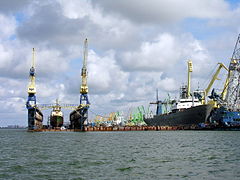Port of Klaipėda
| Port of Klaipėda | |
|---|---|
 | |
 | |
 Click on the map for a fullscreen view | |
| Location | |
| Country | Lithuania |
| Location | Klaipėda, Lithuania |
| Coordinates | 55°43′04″N 21°06′45″E / 55.717778°N 21.1125°E |
| UN/LOCODE | LTKLJ[1] |
| Details | |
| Opened | 1252[2] |
| Owned by | Government of Lithuania |
| Chief Executive Officer | Algis Latakas |
| Statistics | |
| Vessel arrivals | 6 552 (2021) |
| Annual cargo tonnage | 45.62 million (2021) |
| Annual container volume | 666 775 TEU (2021) |
| Passenger traffic | 1076 (2021) |
| Website portofklaipeda.lt | |
The Port of Klaipėda (Lithuanian: Klaipėdos uostas) is a seaport located in Klaipėda, Lithuania. It is one of the few ice-free ports in northernmost Europe, and the second largest European Union port by tonnage in the Baltic.[3] It serves as a port of call for cruise ships as well as freight transport. Regular cargo and passenger ferry lines connect to German and Swedish ports Kiel, Travemünde, Rostock, Karlshamn and Trelleborg.
Main deepsea container lines operating in Klaipėda port are: Maersk, MSC, CMA-CGM, Happag-Lloyd, One, Evergreen, OOCL, Cosco.
Shortsea carriers operating in Klaipėda port: Unifeeder, ViaSea, X-press.
History
[edit]

The city of Klaipėda (Memel) has been involved in maritime trade as early as the 13th century,[2] and probably during prehistoric times, since it is located on the Amber Road. For several centuries its administration as well as its merchants defended the port and it was heavily fortified. In the Grand Duchy of Lithuania, most of the trade was handled via the Port of Danzig, Port of Königsberg and Port of Riga.[4] Therefore, Klaipėda emerged as a major trading port only in recent centuries. At the beginning of the 20th century the port was transferred to the jurisdiction of the Ministry of Transport of Lithuania. Before World War I, the major cargo was timber. During the 20th century, mineral and cellulose enterprises were established in Lithuania, and became port commodities. Infrastructure supporting the fishing and shipbuilding industries were also built.

Current operations
[edit]
Klaipėda State Seaport Authority (Lithuanian: Klaipėdos valstybinio jūrų uosto direkcija) was established in 1991, soon after the restoration of Lithuania's independence. It administers the port and supports its integration into the larger scheme of Lithuanian transport. The Port Authority is responsible for the maintenance, reconstruction and modernisation of the port infrastructure, while loading and unloading operations are managed by separate independent terminals. The port's land and infrastructure belong to the state, but some privatisization is underway.
The Port of Klaipėda is the most northerly ice-free port in the Eastern part of the Baltic Sea. The port can accommodate ships of up to 400 meters in length with draughts of up to 14.3 meters. The port is served by two railway stations and a highways which together link Klaipėda to Kaunas, Vilnius and cities in the nearby countries, such as Minsk, Kyiv and Moscow.
In 1997, 16.13 million tons of cargo were handled at the port, increasing to over 31 million tons in 2010. About 321,000 international passengers transhipped the port of Klaipėda in 2010, on ferries servicing Kiel and Mukran in Germany, Åhus in Sweden, and Copenhagen and Fredericia in Denmark.
In 2015, the Port Authority hired Austrian company Strabag for dredging the shipping channel to the depth of 15 metres.[5]
In 2023, the shipping channel was deepened to 15.5 metres.
In August 2023, it was announced that ~115 million euros will be invested in the infrastructure of offshore wind power plants in the port of Klaipėda.[6]
2023, like 2022, was a successful year for the port in terms of container handling. Annual load exceeded 1 million teu.
Some of the major companies or objects operating in the port:
- BLRT Western Shipyard
- DFDS Seaways
- Limarko laivininkystės kompanija
- Klaipėda LNG FSRU
- Klaipėdos jūrų krovinių kompanija (KLASCO)
- Klaipėdos Smeltė AB
- Klaipėdos Nafta
| Annual cargo turnover, million tonnes[7] | |||||||||||||||||
|---|---|---|---|---|---|---|---|---|---|---|---|---|---|---|---|---|---|
| 2000 | 2001 | 2002 | 2003 | 2004 | 2005 | 2006 | 2007 | 2008 | 2009 | ||||||||
| 19.40 | 17.24 | 19.74 | 21.19 | 20.25 | 21.79 | 23.61 | 27.36 | 29.88 | 27.86 | ||||||||
| 2010 | 2011 | 2012 | 2013 | 2014 | 2015 | 2016 | 2017 | 2018 | 2019 | ||||||||
| 31.28 | 36.59 | 35.24 | 33.42 | 36.41 | 38.51 | 40.14 | 43.17 | 46.58 | 46.22 | ||||||||
| 2020 | 2021 | 2022 | 2023 | ||||||||||||||
| 47.79 | 45.62 | 36.12 | 32.7 | ||||||||||||||
Gallery
[edit]-
Ships in the port
-
Embankment of the cruise ship terminal
-
Cargo loading
-
Harbour
-
Sea gate
-
Cruise ship Costa Magica visiting the port
-
US military equipment transferred as part of Operation Atlantic Resolve
See also
[edit]References
[edit]- ^ "UNLOCODE (LT) - LITHUANIA". service.unece.org. Retrieved 25 April 2020.
- ^ a b "History". Port of Klaipėda. Retrieved 16 October 2021.
- ^ "Port of Klaipeda maintains strong positions". Lithuanian Ministry of Transport. 2021.
- ^ "LDK istorija: Rygos, Karaliaučiaus ir Gdansko vaidmuo Lietuvos prekyboje" [History of GDL: the role of Riga, Königsberg and Gdańsk in Lithuanian trade]. 15min (in Lithuanian). 21 March 2014. Retrieved 5 July 2023.
- ^ "Klaipėdos uosto kanalo gilinimo konkursą laimėjo austrų "Strabag"" (in Lithuanian). Verslo žinios. 27 April 2015. Retrieved 27 April 2015.
- ^ Pryšmantas, Valdas (10 August 2023). "Klaipėdos uoste į jūros vėjo jėgainių infrastruktūrą bus investuojama apie 115 mln. eurų". Lithuanian National Radio and Television (in Lithuanian). Retrieved 10 August 2023.
- ^ "Port statistics". Port of Klaipėda. Archived from the original on 25 June 2022. Retrieved 25 June 2022.







